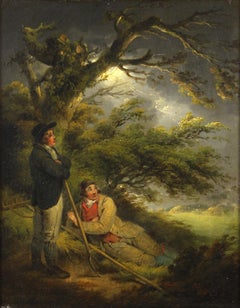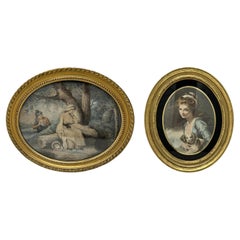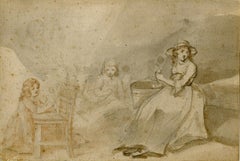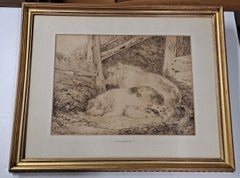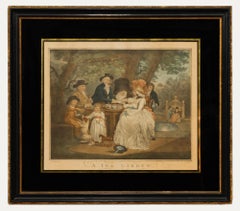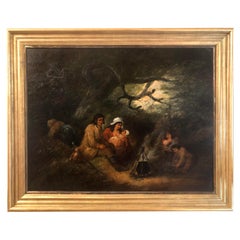George Morland Art
English, 1763-1804
George Morland (26 June 1763 in London – 29 October 1804 in Brighton) was an English painter. His early work was influenced by Francis Wheatley but after the 1790s he came into his own style. His best compositions focus on rustic scenes: farms and hunting; smugglers and gypsies; and rich, textured landscapes informed by Dutch Golden Age painting.to
4
3
7
7
3
3
1
Sheltering from the storm / - Romantic landscape illuminated by lightning bolt -
By George Morland
Located in Berlin, DE
George Morland (1763 London - 1804 Brighton). Sheltering from the Storm. Oil on canvas, relined, 37.5 x 29.5 cm (visible size), 53.5 x 45.5 cm (...
Category
1790s Romantic George Morland Art
Materials
Oil
Antique Regency George Morland Hand Colored Stipple Engraving Lady Gilt Frame
By George Morland
Located in Dublin, Ireland
An exceptional example of a Regency period hand colored stipple Engraving by George Morland titled “The Lass of the Livingstone” complete with its original giltwood ornate oval frame...
Category
19th Century French Grand Tour Antique George Morland Art
Materials
Giltwood
“Pair of Hunt Scenes, Oil on Canvas”
By George Morland
Located in Warren, NJ
This is 2 original oil paintings. Both are beautiful pieces. each lined and with craquelure; Meet by the Farmhouse with a chip in the paint along the left edge and an abrasion along ...
Category
18th Century George Morland Art
Materials
Oil
Girls and Pigs - Etching by William Ward After George Morland - 1797
By George Morland
Located in Roma, IT
Image dimensions: 38.2 x 45.7 cm.
Girl and Pigs is an original etching, hand-colored, d'après George Morland.
Interesting artist's proof by William Ward ...
Category
1790s George Morland Art
Materials
Etching
Family Group
By George Morland
Located in Fairlawn, OH
Family Group
Drawing in Chinese white, sepia and bistre ink, c. 1790
Signed lower left: G. Morland (see photo)
The present work appears to be a preliminary study for two Morland paintings where the artist uses portions of this preliminary study in finished exhibition paintings. The strongest association is with the painting entitled The Cottage Door (1790), now in the collection of Royal Holloway College, University of London. Morland uses the same small girl (on left side of this sheet) holding a doll on a chair in the exact same pose. The second painting entitled The Tea Garden (Tate Gallery, London, c. 1790) incorporates similar poses and gestures of the three other figure studies on this sheet.
Provenance: Colnaghi, London (Stock # D25924, see photo)
Maynard Walker Gallery, New York ( see photo of label)
Davis Galleries, New York, their Eagle stamp and stock number (see photo)
Ms. Gloria Kaplan (1930-2011) New York City
Regarding Maynard Walker:
Maynard Walker New York Times obit:
"Maynard Walker, an art dealer in New York City for nearly 40 years who was among the first to show the works of leading American regionalist painters, died of pneumonia Tuesday at St. Joseph's Hospital in Carbondale, Pa. He was 89 years old and lived in Lake Ariel, Pa.
In 1933, while working at the Ferargil Gallery in New York, Mr. Walker organized an exhibition for the Kansas City Art Institute that for the first time brought together the work of the regionalist painters Grant Wood, Thomas Hart Benton and John Steuart Curry.
After Mr. Walker opened his own gallery, at 108 East 57th Street, in 1935, these artists joined him and showed regularly there. The gallery was also among the first to show the work of George Grosz, the German painter and caricaturist, who moved to the United States in 1932. The gallery moved to 117 East 57th Street after the war."
Condition: Aging to paper
Slight fading to ink
Tiny spotting in image
All consistent with the age of the drawing
Image size: 6 3/8 x 9 1/2 inches
Frame size: 14 1/4 x 17 1/4 inches
George Morland was born in London on 26 June 1763. He was the son of Henry Robert Morland, and grandson of George Henry Morland, said by Cunningham to have been lineally descended from Sir Samuel Morland, while other biographers go so far as to say that he had only to claim the baronetcy in order to get it. Morland began to draw at the age of three years, and at the age of ten (1773) his name appears as an honorary exhibitor of sketches at the Royal Academy. He continued to exhibit at the Free Society in 1775 and 1776, and at the Society of Artists in 1777, and then again at the Royal Academy in 1778, 1779 and 1780.
His talents were carefully cultivated by his father, who was accused of stimulating them unduly with a view to his own profit, shutting the child up in a garret to make drawings from pictures and casts for which he found a ready sale. The boy, on the other hand, is said to have soon found a way to make money for himself by hiding some of his drawings, and lowering them at nightfall out of his window to young accomplices, with whom he used to spend the proceeds in frolic and self-indulgence. It has been also asserted that his father, discovering this trick, tried to conciliate him by indulgence, humouring his whims and encouraging his low tastes.
He was set by his father to copy pictures of all kinds, but especially of the Dutch and Flemish masters. Among others he copied Fuseli's Nightmare and Reynolds's Garrick between Tragedy and Comedy. He was also introduced to Sir Joshua Reynolds, and obtained permission to copy his pictures, and all accounts agree that before he was seventeen he had obtained considerable reputation not only with his friends and the dealers, but among artists of repute. A convincing proof of the skill in original composition which he had then attained is the fine engraving.
It is said that before his apprenticeship to his father came to an end, in 1784, Romney offered to take him into his own house, with a salary of £300, on condition of his signing articles for three years. But Morland, we are told, had had enough of restraint, and after a rupture with his father he set up on his own account in 1784 or 1785 at the house of a picture dealer, and commenced that life which, in its combination of hard work and hard drinking, is almost without a parallel.
Morland soon became the mere slave of the dealer with whom he lived. His boon companions were "ostlers, potboys, horse jockeys, moneylenders, pawnbrokers, punks, and pugilists." In this company the handsome young artist swaggered, dressed in a green coat, with large yellow buttons, leather breeches, and top boots. "He was in the very extreme of foppish puppeyism", says Hassell; "his head, when ornamented according to his own taste, resembled a snowball, after the model of Tippey Bob, of dramatic memory, to which was attached a short, thick tail, not unlike a painter's brush." His youth and strong constitution enabled him to recover rapidly from his excesses, and he not only employed the intervals in painting, but at this time, or shortly afterwards, taught himself to play the violin. He made also an effort, and a successful one, to free himself from his task-master, and escaped to Margate, where he painted miniatures for a while. In 1785 he paid a short visit to France, whither his fame had preceded him, and where he had no lack of commissions.
Returning to London, he lodged in a house at Kensal Green, on the road to Harrow, near William Ward, intercourse with whose family seems for a time to have had a steadying influence. It resulted in his marriage with Miss Anne Ward...
Category
1790s English School George Morland Art
Materials
Ink
George Morland (1763-1804) "Piglets" Original Watercolor
By George Morland
Located in San Francisco, CA
George Morland (1763-1804) "Piglets" original watercolor on paper
Signed & Dated 1791
Unframed 14" x 18"
Framed 21" x 26"
Category
18th Century George Morland Art
Materials
Watercolor
Conversation at the gate
By George Morland
Located in Douglas, Isle of Man
George Morland 1763-1804, was an English painter who was influenced by the painter Francis Wheatley , landscapes. After 1790 he had developed his own style of painting adopting rusti...
Category
18th Century George Morland Art
Materials
Watercolor, Paper
"Suite Of Four Gamebird Shooting Scenes" By George Morland
By George Morland
Located in Bristol, CT
Partridge Shooting/ Snipe Shooting/ and 2 Duck Shooting scenes
Print Sz: 11 3/4"H x 13"W
Frame Sz: 17 3/4"H x 20"W
By J. Pocker & Son
George Morlan...
Category
18th Century George Morland Art
Materials
Lithograph
Related Items
19th century American watercolor - Flowers Butterfly Alps Switzerland Germany
Located in Aartselaar, BE
This beautiful and vibrant 19th century American watercolor is an hommage by Paul de Longpré to the Alps, as it features a rich variety of Alpine flowe...
Category
Late 19th Century George Morland Art
Materials
Watercolor
$4,623
H 25 in W 20 in D 1 in
Italian 18th Century Oval Religious Oil on Canvas Painting with Saint Dominic
By Francesco de Mura
Located in Firenze, IT
This beautiful Italian 18th Century old masters oil painting on oval canvas with giltwood frame is attributed to Solimena and features a religious scene.
In this splendid oval-shaped painting are depicted Saint Dominic...
Category
18th Century Old Masters George Morland Art
Materials
Canvas, Oil
$13,210
H 21.66 in Dm 15.75 in
Six Hand Colored Coral Engravings in Burl Wood Frames
Located in San Francisco, CA
19th century, hand colored engravings of various coral specimens in tones of green and pink; framed in stained green, burled wood frames. Antique, Pa...
Category
19th Century English Antique George Morland Art
Materials
Burl, Paper
$2,900 Sale Price / set
40% Off
H 20 in W 18 in D 0.5 in
J. Brunner 1869 Oil on Canvas Austrian Landscape with Lake and Mountain Painting
Located in Firenze, IT
This very fine quality 19th century oil on canvas in dark brown wood frame with gold leaves details throughout is signed by Joseph Brunner (Vienna 1826-...
Category
19th Century Romantic George Morland Art
Materials
Canvas, Wood, Oil
Joseph BrunnerJ. Brunner 1869 Oil on Canvas Austrian Landscape with Lake and Mountain Painting, 1869
$8,887
H 30.32 in W 43.31 in D 1.97 in
Antique American Impressionist Young Girl and Pug Dog Portrait Framed Painting
Located in Buffalo, NY
Antique American impressionist oil painting by Frederick Stuart Church (1842 - 1924). Gouache and watercolor on board. Framed. Measuring: 17 by 23 inches overall, and 10 by 16 painti...
Category
1880s Impressionist George Morland Art
Materials
Watercolor, Gouache, Archival Paper
$5,750
H 17 in W 23 in D 2 in
19th Century English Colored Engraving
Located in Scottsdale, AZ
John Harris (1791-1873), after Bennett Hubbard (fl.1839-1864), ''Cure-All'', Winner of the Grand National Liverpool Steeple Chase, 1945, Ridden by the Owner, Mr. W.G. Loft, of Healin...
Category
19th Century French Napoleon III Antique George Morland Art
Materials
Wood, Paint
Harvest Scene With Farmer and Scythe, 1886
Located in Stockholm, SE
"Harvest Scene With Farmer and Scythe, 1886" is a captivating painting by the Swedish artist Alfred Thörne. Created during his travels through Germany, France, Italy, and Belgium bet...
Category
1880s Romantic George Morland Art
Materials
Canvas, Oil
From St. Martin's, Parkstone
Located in Middletown, NY
A lovely coastal view of Dorset from the bluffs of what is now Parkstone Golf Club.
1895. Ink and wash on wove paper, 7 1/2 x 11 inches (190 x 280 mm), the full sheet. Signed in ink...
Category
Late 19th Century English School George Morland Art
Materials
Ink
Two views of the sea, Dorset
Located in Middletown, NY
Two watercolor compositions on one sheet of watercolor paper, 10 x 6 7/8 inches (255 x 175 mm), the full sheet. Signed illegibly and dated in pencil on the lower right corner of the ...
Category
Late 19th Century English School George Morland Art
Materials
Watercolor, Pencil, Ink
Antique American Modernist Chickens Grazing Bucolic Landscape Framed Painting
Located in Buffalo, NY
Antique American modernist painting. Watercolor and gouache on paper. Framed. Signed. In excellent original condition. Handsomely framed in a modern molding. Excellent condition, ...
Category
1950s Modern George Morland Art
Materials
Watercolor, Gouache, Archival Paper
$975
H 23 in W 26 in D 2 in
Birds - XXI century, Figurative print, Black and white, Animals
By Anna Mikke
Located in Warsaw, PL
Limited edition, 8/10. ANNA MIKKE (born in 1950) She graduated from the Academy of Fine Arts in Łódź in 1975. After graduation, she was engaged in graphic design, including designing...
Category
2010s Other Art Style George Morland Art
Materials
Paper, Etching
$180
H 4.73 in W 10.04 in
Courtship in the Forest French Romantic School XIX century oil on canvas
Located in Sitges, Barcelona
Title: *Courtship in the Forest*
Author: French Romantic School
Technique: Oil on canvas
Support: Canvas mounted on a stretcher
Unframed dimensions: 11.4 x 7.9 inches
Frame...
Category
Late 19th Century Romantic George Morland Art
Materials
Canvas, Oil
$962 Sale Price
30% Off
H 11.42 in W 7.88 in
Previously Available Items
Francois David Soiron after George Morland - Stipple Engraving, A Tea Garden
By George Morland
Located in Corsham, GB
This early engraving captures a bustling Georgian scene in detail. The composition draws the eye down a central thoroughfare where a family sits to enjoy afternoon tea in a beautiful...
Category
19th Century George Morland Art
Materials
Engraving
Late 18th Century Oil Painting "The Gypsy Family Encampment" by George Morland
By George Morland
Located in Chapel Hill, NC
"The Gypsy Family Encampment", George Morland, 1791, oil on canvas. (George Morland, England, 1763-1804). Signed & dated lower right. A classic of the zenith period, the 1790s., of M...
Category
Late 18th Century English Romantic Antique George Morland Art
Materials
Canvas, Paint
H 34 in W 42 in D 2 in
The Farrier
By George Morland
Located in Stoke, Hampshire
George Morland (1762-1804)
The Farrier
Signed and dated 'G Morland, 1793' lower left
Oil on canvas
Canvas Size - 27 5/8 x 36 in
Framed Size - 35 x 43 in
Geo...
Category
18th Century Old Masters George Morland Art
Materials
Oil
Sheltering from the storm - Romantic landscape illuminated by lightning bolt -
By George Morland
Located in Berlin, DE
George Morland (1763 London - 1804 Brighton). Sheltering from the Storm. Oil on canvas, relined, 37.5 x 29.5 cm (visible size), 53.5 x 45.5 cm (...
Category
1790s Old Masters George Morland Art
Materials
Canvas, Oil
A white horse sheltering from a storm
By George Morland
Located in Stoke, Hampshire
George Morland (1763-1804)
A white horse sheltering from a storm
Oil on canvas
Painting Size 11 3/8 x 13 3/4 in
George Morland was born in June 1763. An English painter, mainly of s...
Category
18th Century English School George Morland Art
Materials
Oil
George Morland, Figures drinking outside an Inn
By George Morland
Located in Harkstead, GB
A charming rustic scene with figures drinking outside a tavern. Painted on a lovely old oak panel with labels and a wax seal.
George Morland (1763-1804)
Figures outside an Inn
Oil on panel
With seal and labels to the reverse
7 x 6 inches
10 x 9 inches including the frame
George Morland (26 June 1763 in London – 29 October 1804 in Brighton) was an English painter. His early work was influenced by Francis Wheatley but after the 1790s he came into his own style. His best compositions focus on rustic scenes: farms and hunting; smugglers and gypsies; and rich, textured landscapes informed by Dutch Golden...
Category
Late 19th Century Old Masters George Morland Art
Materials
Oil, Wood Panel
GEORGE MORLAND R.A. - ORIGINAL OIL CANVAS - BOATS HEADING OUT ISLE OF WIGHT
By George Morland
Located in Marlow, Buckinghamshire
A beautiful original oil on canvas by George Morland R.A. the important english landscape and figure painter who worked din the 18th century. This large canvas depicts boats heading ...
Category
18th Century Old Masters George Morland Art
Materials
Oil
Barn Interior With Horses & Figures, circa 1800
By George Morland
Located in Blackwater, GB
Barn Interior With Horses & Figures, circa 1800
by GEORGE MORLAND (1763-1804) sales to $190,000
Large 18th Century English Barn interior scene with farm workers and various horses entering at the end of the days work, oil on canvas by George Morland. Excellent condition for its age, signed top right on the rag covering the window. Leading example of the artists work, presented in a good frame ready to hand and professionally relined and restretched (will not need any conservation for another 50 years). Rare leading example of the artists work.
Measurements: 46" x 36" framed approx
GEORGE MORLAND 1763-1804
George Morland was born in London on 26 June 1763. He was the son of Henry Robert Morland and grandson of George Henry Morland. He began to draw at the age of three and at the age of ten his name appears as an honorary exhibitor of sketches at the Royal Academy. He continued to exhibit at the Free Society in 1775 and 1776, and at the Society of Artists in 1777 before exhibiting again at the Royal Academy in 1778, 1779 and 1780.
His talents were carefully cultivated by his father, who was accused of stimulating them unduly with a view to his own profit, shutting the child in a garret to make drawings from pictures and casts for which he found a ready sale. The boy on the other hand, is said to have soon found a way to make money for himself by hiding some of his drawings and lowering them at nightfall out of his window to young accomplices, with whom he used to spend the proceeds in frolic and self-indulgence.
He was set by his father to copy pictures of all kinds, but especially of the Dutch and Flemish masters. Among others, he copied Fuseli's ‘Nightmare’ and Reynolds's ‘Garrick between Tragedy and Comedy’. He was also introduced to Sir Joshua Reynolds and obtained permission to copy his pictures and, all accounts agree, before he was seventeen he had obtained a considerable reputation not only with his friends and the dealers but among artists of repute. A convincing proof of skill in original composition, which he had then attained, is the fine engraving by William Ward after his picture of ‘Angler's Repast’ which was published in November 1780 by John Raphael Smith.
Morland went to Margate where he painted miniatures for a while and then paying a short visit to France in 1785, where his fame had preceded him and he had no lack of commissions. Returning to London, he lodged in a house, at Kensal Green on the road to Harrow, near to his friend William Ward whose family seems to have had a steadying influence. It resulted in Morland's marriage to Miss Anne Ward...
Category
19th Century George Morland Art
Materials
Canvas, Oil
A gentleman shooting in a landscape, with his horse and dog
By George Morland
Located in Stoke, Hampshire
George Morland (1763-1804)
A gentleman shooting in a landscape
Oil on canvas
17 7/8 x 24 1/8 in
45.5 x 61 cm
George Morland was born in June 1763. An English painter, mainly of scen...
Category
18th Century George Morland Art
Materials
Oil
Heading home with the days catch
By George Morland
Located in Stoke, Hampshire
GEORGE MORLAND (BRITISH 1762/63-1804)
Heading home with the days catch - Beach scene landscape
Signed with initials lower right
oil on canvas
28 x 36 in
George Morland was the eldes...
Category
18th Century George Morland Art
Materials
Oil
Winter Games - 18th Century Oil, Figures in Snow Landscape by George Morland
By George Morland
Located in Marlow, Buckinghamshire
A wonderfully painted oil on canvas by George Morland depicting children playing outside a cottage on a snowy winter's day. Signed lower right.
George Morland was the son of the pastel portraitist, dealer and restorer Henry Robert Morland and the grandson of the genre painter George Henry Morland. He was taught by his father and first exhibited at the Royal Academy at the age of fifteen. Until the age of twenty-one, he devoted his entire existence to his work, his only friend being the painter and engraver Philip Dawe. In 1784, George Romney offered him a position as his assistant, but Morland refused, because he wanted to enjoy his freedom. In any case, the young artist had already produced works that had met with great success, such as The Angler's Repast, which had been painted when he was barely seventeen years old and was reproduced by William Ward. At first Morland painted portraits in Margate and at St-Omer in France. In 1876 he went back to London, where he married the sister of the engraver William Ward. Shortly afterwards, Ward married Morland's sister, and this double alliance cemented a collaboration which provided the English School with a considerable number of attractive and interesting prints.
At the start of his career, Morland was mainly a painter of childhood. He depicted an English ideal of childhood in all its prettiness, with a pleasant, even witty touch. He had the gift of working with great ease and produced a large number of paintings in this genre. In the years 1788 and 1789 alone, no less than 59 engravings after Morland appeared. They were mezzotints of elegant scenes of childhood, executed by the finest artists.
From 1790, Morland broadened his range, painting a greater variety of subjects. Though children still appeared in some of his pictures, they rarely played the principal part in the way they had previously done. On the other hand, horses, sheep, pigs and poultry feature in a large number of canvases. It was also around this time that he produced his series of recruits and deserters, and his gypsies, fishermen, and scenes of inns and public coaches. He was earning a lot of money, but he was spending even more, and he was obliged to retreat to a country dwelling in Leicestershire. This stay in the country had a considerable influence on his talent and sharpened his taste for landscape.
When Morland returned to London in around 1792, he suffered the consequences of his past follies, as his creditors had obtained warrants for his arrest, and he lived in hiding for several years in order to avoid imprisonment. In the end he grew tired of this and in 1799 he took refuge in a cottage near Cowes on the Isle of Wight, which had been lent to him by a friend. He remained there for almost a year, living among the sailors and fishermen, where he found many typical faces he could use in his paintings. His return to London early in 1800 was swiftly followed by his imprisonment for debt. Briefly released in 1802, he was imprisoned again following an apoplectic fit, which left him unable to work. His wife survived him by only a few days.
Morland is an interesting figure in the English School, an artist full of charm and verve. He left a considerable body of work. According to his family, during the last eight years of his life, he produced around eight hundred paintings and more than a thousand drawings.
Museum and Gallery Holdings
Bath (Holburne Mus. of Art): Horse and Dog in a Stable (1791, oil on canvas); The Deserter Pardoned (1792, oil on canvas)
Birmingham (Mus. and AG): Pigs (oil on canvas); Shooting Sea Fowl (oil on canvas)
Bristol: Interior with Sheep
Bristol (City Mus. & AG): Quarry Scene (two); Gypsies in a Landscape (oil on canvas); Man Grooming Horse; Boy Seated on a Drinking Horse
Budapest: Pigsty
Dublin: Landscape with Figures and Cattle
Edinburgh: study
Glasgow: Smugglers on the Shore; Storm and Shipwreck; Seascape
Leeds (City AG): Coast Scene (oil on canvas)
Leicester: Calm Sea off the Isle of Wight
London (National Portrait Gal.): George Morland (c. 1775-1780, oil on canvas); Henry Robert Morland (pencil, father of the artist); George Morland (c. 1795, chalk)
London (Tate Collection): Inside of a Stable (exhibited in 1791, oil on canvas); Outside the Ale-House Door (1792, oil on canvas); Door of a Village Inn (oil on canvas); Rabbiting (1792, oil on canvas); The Fortune Teller (oil on canvas)
London (Victoria and Albert Mus.): Farmer Paying his Bill to the Innkeeper; Horses in a Stable; Fishermen; Fishing Boats with Figures; Girl Stroking a Pigeon; Johanny Going to the Fair; Hunting Scene; Farmyard; Cottage, Farm Cart and Dog
London (Wallace Collection): A Visit to the Boarding School (1789, oil on canvas)
Manchester: watercolours
Montreal (Learmont Collection): Village Brewery
New York: Town-Country
Nottingham (Castle Mus. & AG): The Wreckers; The Artist in his Studio; Sportsman Resting; Two Horses in the Snow...
Category
Late 18th Century Old Masters George Morland Art
Materials
Canvas, Oil
Travellers in Woodland Shelter Georgian Oil Painting
By George Morland
Located in Cirencester, Gloucestershire
Travellers Resting
Attributed to George Morland (British 1763-1804)
oil painting on canvas, framed
canvas: 28 x 34 inches
framed: 34.5 x 40 inches
Very fine antique English oil painting on canvas depicting this group of travellers resting under the protection of the mighty oak tree in this wooded landscape. The painting is of exceptional quality and may be attributed to the British painter, George Morland (1763-1804). It dates to the circa 1790-1800 period.
Painted on this grand, exhibition scale, the work beautifully captures this resting family, including the pet dog, taking shelter...
Category
Late 18th Century Victorian George Morland Art
Materials
Oil
George Morland art for sale on 1stDibs.
Find a wide variety of authentic George Morland art available for sale on 1stDibs. You can also browse by medium to find art by George Morland in paint, oil paint, canvas and more. Much of the original work by this artist or collective was created during the 18th century and is mostly associated with the Old Masters style. Not every interior allows for large George Morland art, so small editions measuring 6 inches across are available. Customers who are interested in this artist might also find the work of George Wright , William Edward Frost, and Francis Plummer. George Morland art prices can differ depending upon medium, time period and other attributes. On 1stDibs, the price for these items starts at $750 and tops out at $25,355, while the average work can sell for $6,981.
